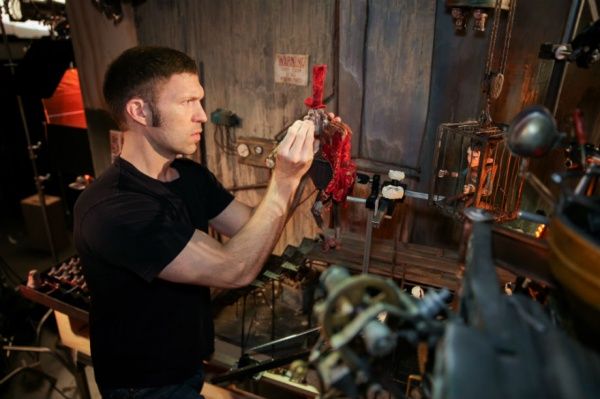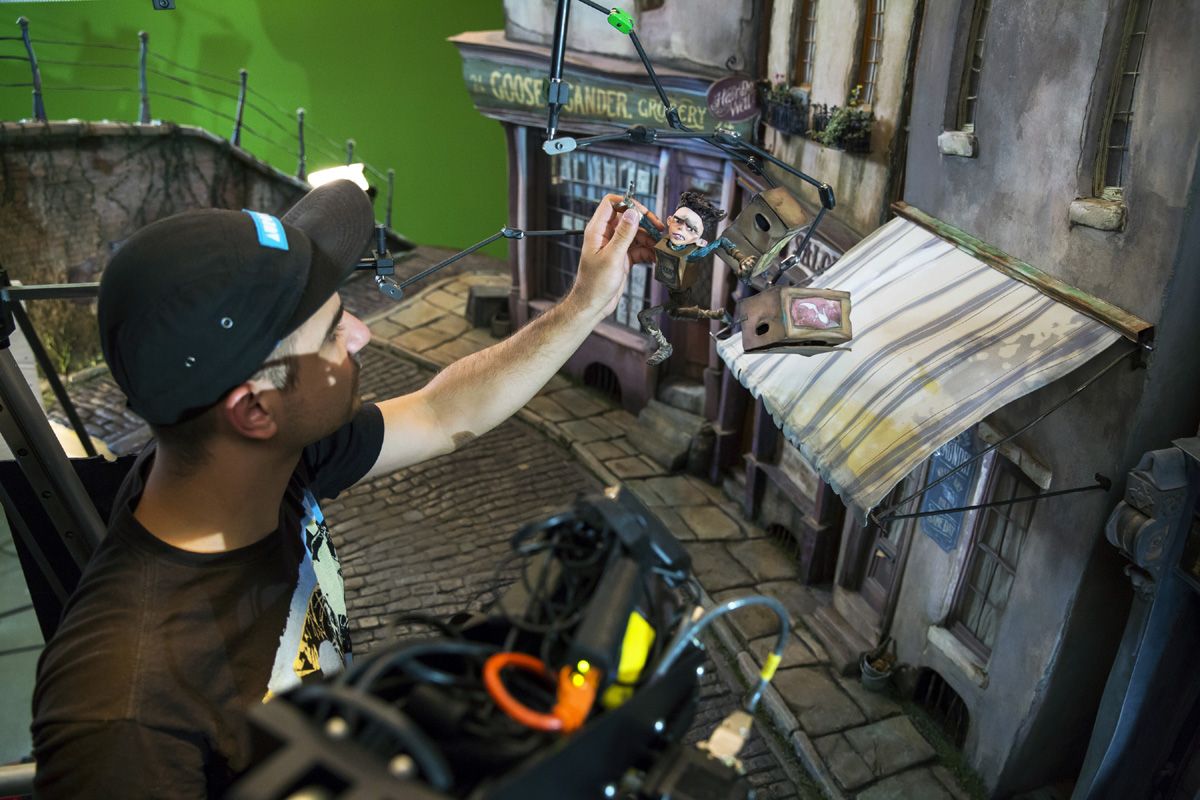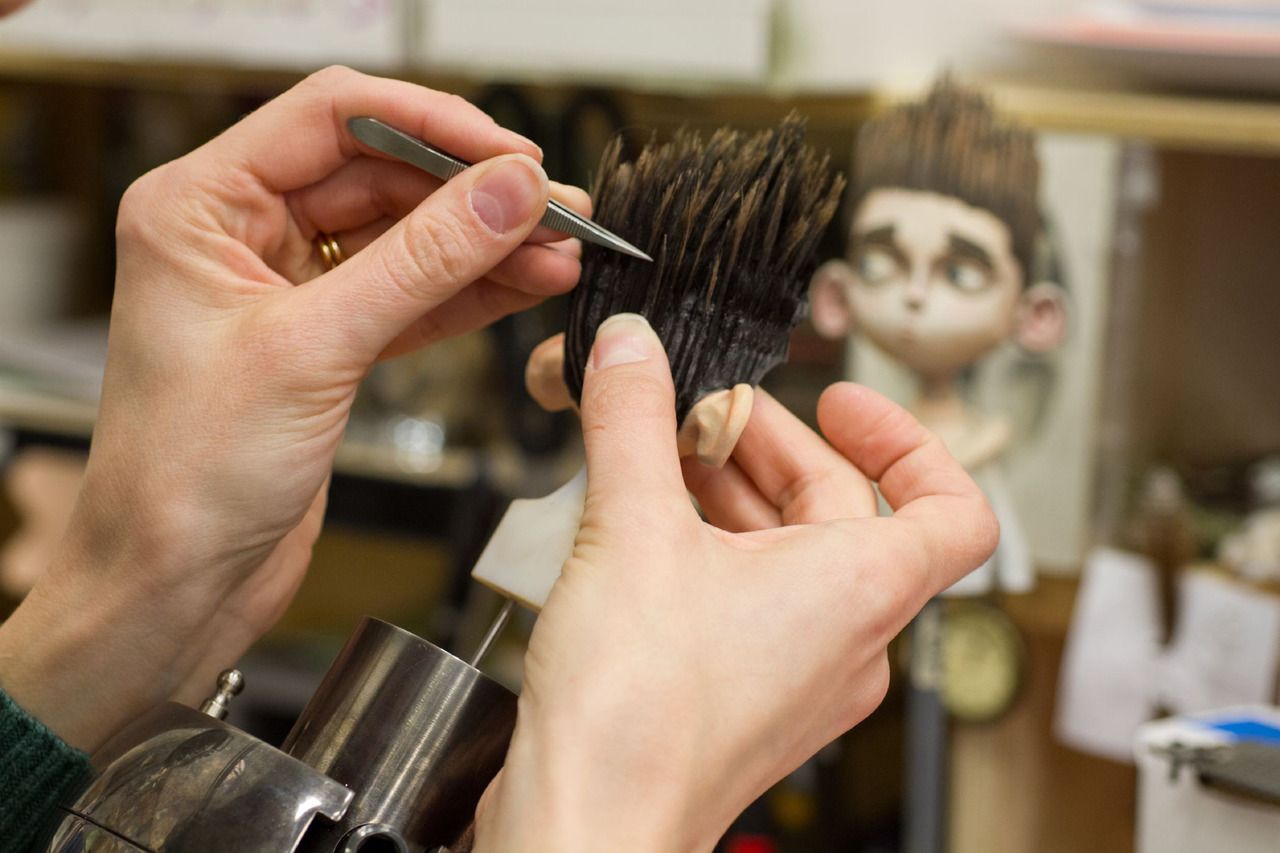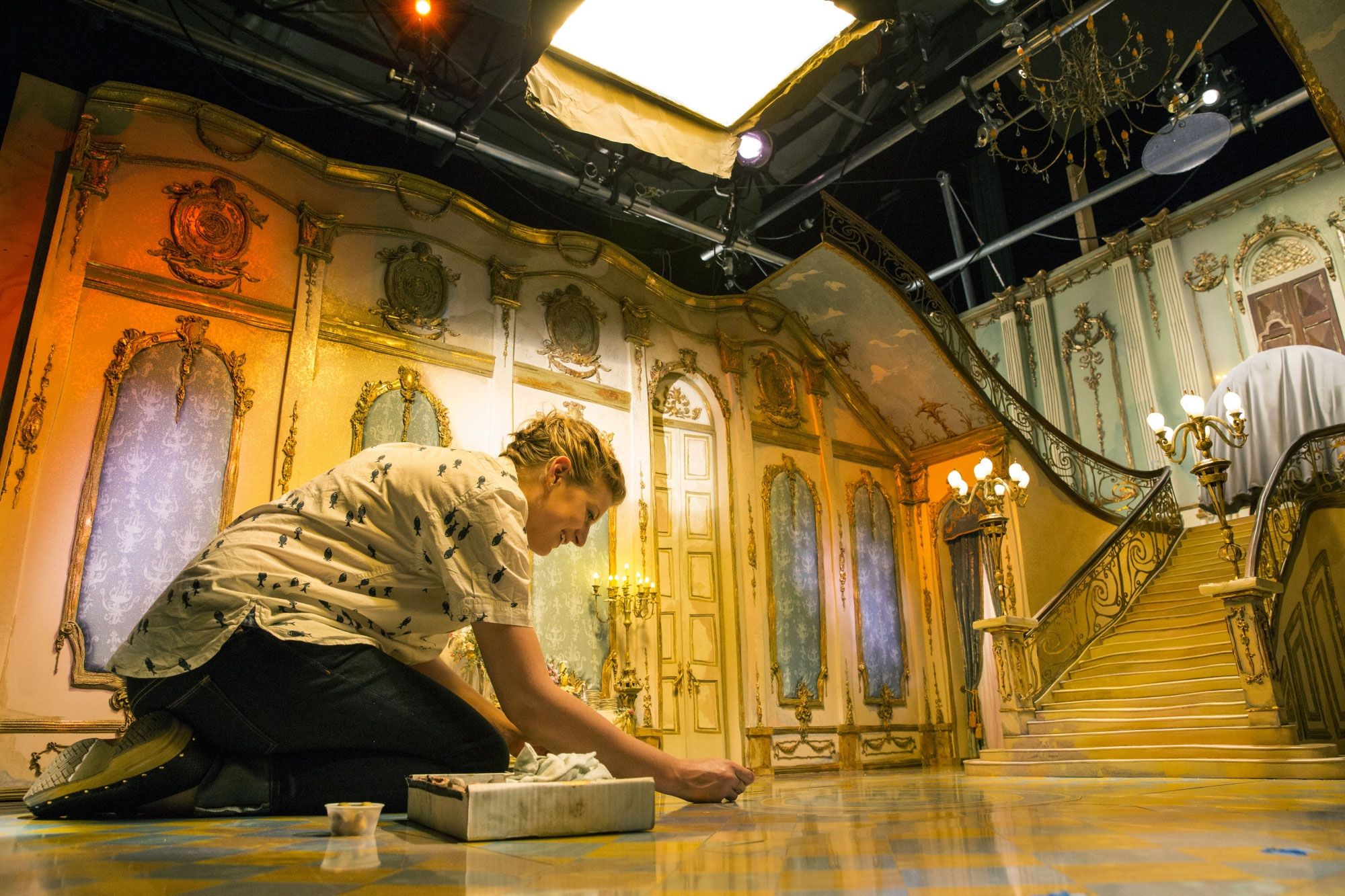Frame by frame, Laika has steadily become a major mover and shaker in the world of film animation. With each new release – beginning in 2009 with Coraline and continuing in 2012 with ParaNorman and, now, The Boxtrolls – the studio has revitalized stop-motion animation and, like the technique itself, each small movement has ultimately added up to something magical.
As CEO Travis Knight reveals in an interview Spinoff Online, Laika’s methodical ethic is melded to technological innovation and an ambitious, and off-kilter, creative sensibility.
Spinoff Online: One of the things that I really liked about this film was that a lot of animated features can really lean on pop cultural references and that sort of thing, and this has such a timeless feel – but also it was timelessly funny. You guys made it a funny movie, without having to pull in easy referential jokes. So when did that decision get made, and how hard was it to maintain that without going for sort of an easier laugh?
Travis Knight: It’s tricky. I mean, I think part of that goes just to the core philosophy of the kind of films that we make. I mean, we want to make films that are bold, that are distinctive, but that are also enduring. And part of that core philosophy is to not do things that are just little pop culture confections, that are ephemera, that kind of resonate for the moment because it happens to be something going on in the zeitgeist, but you look back a handful of years later, and it feels dated as you can imagine. It’s like we want somebody to be able to watch Coraline or ParaNorman or Boxtrolls 10, 20 years from now, and have the same kind of enjoyment that the audience would have right now. And part of that is to the timeless quality of it – in the emotion, but also in the humor. It is tricky: It’s a challenge, because it’s easier to go for those kind of quick pop-culture gags or, you know, bodily functions or stuff like that. And those things have their place, and I think that they can be done well; they can be done cleverly. But when you imagine that this film takes place in some kind of imagined Victorian era, I think you can’t help but take the audience out of that if you’re starting to reference pop culture things, you have to find humor that is kind of more universal. It’s more subtle. It’s harder, but I think it makes the film feel more successful and feel like it’s in this authentic time period, when you’re not referencing TV shows or pop-culture icons or whatever.
"Boxtrolls" Directors Push Stop-Motion Animation to New Levels
Three movies in, and you have a pretty intact filmmaking team.
Yes. We kept the band together!
How did this one push the envelope for them? I’m sure there were a lot of standards that you set on the other films that you wanted to maintain, but how did you also push them forward?
When we started with Coraline, it was an unusual thing, because at the core of what we were doing we wanted to try to find ways to take this age-old art form – this thing that had been around since the dawn of cinema: stop-motion, which hadn’t changed dramatically in the hundred years it had been in existence – and try to find ways to merge that with technology, with essentially the thing that was trying to put us out of business, which was, you know, CG and all that kind of stuff. How could we take the best elements of that to enhance the process? And so we started with that on Coraline, did a lot of new innovation, a lot of radical things. One of those things was rapid prototyping; the first time we’d used that in a different way, in a more limited way, on Coraline. And by keeping the band together, by keeping that team together, all the innovations, all the different processes that evolved over the course of that film, we were then able to apply to ParaNorman. Then all the things we learned while we were making ParaNorman, we could then apply to The Boxtrolls. And so innovations – evolution that happened in every single department from costume to puppet making to camera to rapid prototyping and visual effects to enhance animation – all the different things that we learned over the course of that five, six years, we were able to then apply to the new film. Which meant that there were things we could do on Boxtrolls that we couldn’t even imagine on Coraline, and I think you see it. You see the kind of visual sophistication of the film. It’s kind of dramatically more nuanced. It’s more sophisticated than Coraline or even ParaNorman. It’s because that team continues to push on what’s possible in the medium and to try to take it where it’s never been before and not make it feel like little dolls shot on a table top – which is really what they are – to make it feel like a real lived in world, with living, emoting characters that audiences can connect with, and I’m very proud of what we all came up with.
"The Boxtrolls" Star Elle Fanning Talks Accents, Stop-Motion and Obsessions
What do you love about the stop-motion technique that keeps you passionate about it?
There’s kind of an immediacy to it, when you’re animating – I’ve animated hand-drawn animation, I’ve done CG animation, and I’ve done puppet animation, stop-motion animation, and whenever you’re doing something hand-drawn, it’s an iterative process. You know, you’re kind of coming up with your key poses, and then you’re coming back and doing your in-betweens. You can even change things. You can take drawings out. You can add them and then they can get colored or what have you. And so, it’s this long drawn out process to get to something that’s a finished product. With CG, it’s the same sort of thing. You’re dealing with kind of a low-res model and kind of a low-res set. It’s an iterative process you’re going through. You’re kind of building the performance. With stop motion, it’s so simple. It’s so intuitive, and yet, like most things that are simple, it’s one of the hardest things in the world to do well. You have a puppet that’s in a real set, bathed in a real light, shot by a real camera, and you take your first frame, and that’s it. It’s done. You go on to the second frame. You take the frame, that’s it, it’s done. And you really, you can’t go back. It’s really a performance art, in that way. It takes so long, it’s horrible. It’s a really awful process, but there’s an immediacy to it, a spontaneity to it, because you’re capturing a performance a frame at a time. And so whatever comes out at the other end, that was something that was through the hands of an artist, and I think there’s something about that, something about the process, that I think process is inextricable from the art itself. And so whatever the mentality is that a stop motion animator has to bring to the performance, it’s different than what you would see in a live-action film, or hand-drawn or CG-animated film. And I think that’s part of it: It’s just being able to get in there, to touch, move the thing around, it’s almost – to me, its evocative of being a kid, of playing with your action figure, or your doll. The imagined life that you have in your head that these things have – this inner life that maybe you think your doll has – it’s like that’s kind of what it’s like with stop motion. It’s just brought a kind of recorded version of that.
Tell me what the stop-motion project was that was the “gateway drug” for you? The first thing that got you hooked on that concept. And what’s the gold standard? One you’ve always aspired to capture that same kind of magic?
You know, I think like most kids, I loved animation generally. But I did have a special attraction and affinity for stop-motion animation, and I think it goes back to that idea of kind of these playthings being brought to life. You know, all the kind of the great Rankin/Bass stuff, the kind of Rudolph the Red-Nosed Reindeer that you would see every year, Mad Monster Party and Nestor [the Long-Eared Christmas Donkey] and all those sorts of things. But for me, it didn’t get any better than the Ray Harryhausen creature features. When I would come home from school, and there would be a kind of run of those, or on a Saturday morning that stuff would be on. Things like 7th Voyage of Sinbad or Jason and the Argonauts. To me, that was as good as it gets. Those were such fun, compelling action films, and they had these weird monsters and creatures that -- I think really the gold standard is from Jason and the Argonauts, which is kind of the skeleton battle. It’s just, to this day, it’s mind-blowing. Can you imagine Ray kind of being able to keep – he didn’t have frame-grabbers, he didn’t have the technology that we have now. Being able to keep all that kind of stuff in his head, and to be able to mathematically and mechanically figure out how it would all work, and yet to make these things feel like they’re alive. It blows my mind that he was able to do that generations ago, and I still think that to this day it holds up. It’s just a beautiful piece of filmmaking.
Ben Kingsley Brings Gravitas to "The Boxtrolls," But He's No "Serious Actor"
With this 3D-printing process now, which is able to include all the color, has that dramatically changed the range of facial expressions?
It has. We used rapid prototyping on Coraline, but we were only able to print kind of like in a pewter, kind of gray color, which meant that every single face had to be hand-painted, with which you were still able to get nice, broad expression, and some subtlety, but it limited the design. We could only go so far with it. Coraline had like I think 13 freckles, whatever it was – six on one side, seven on the other – and they all had to be hand-painted. So the designs and the textures had to be pretty simplistic, because from frame to frame, you would see all that stuff buzzing around if it didn’t line up just perfectly. ParaNorman was the first time we brought color printing into the mix, and what that allowed us to do was get greater verisimilitude to the face. It looked more like skin. It had more texture on it. Neil had hundreds and hundreds of freckles, compared to Coraline’s 13, which made them feel more real, more lifelike. And once we could kind of approximate reality, which we were able to do with ParaNorman, we wanted to take it in a different direction.
We wanted to go theatrical, we wanted to go more impressionistic – which what we were doing with the character design and the set design, the production design, inspired by some of the greatest impressionistic painters, we really wanted to bring that, almost like a moving painting, into the faces. And the evolution, the innovations that we’d come up with on Coraline and ParaNorman, we were able to get these amazing paint jobs on these characters’ faces, where you take these really odd things, these ideas, these opposing colors, these reds and blues, and put them right next to each other. It looks weird, it looks wrong. And figuring out how that would move, how that would articulate, as the volume would shift around on the faces was really tricky. But then, once we figured out how to do all that, then the characters were really elastic and the faces were very expressive, and they still had these amazing paint jobs. It made it feel like it was a whole unified design world, and the characters didn’t stand out from the environments, because they all had the same kind of treatment. And it really was a kind of remarkable thing, moving from the design team, to the puppet paint department and then the rapid prototyping department to figure out how to bring this stuff together, and I’m incredibly proud of it. I think it’s just a beautiful, beautiful thing.
CBR TV: Annable, Stacchi & Hempstead-Wright Bring Stop-Motion Magic to “The Boxtrolls”
Stop-motion projects of late tend to have sort of commonness in creepiness – there’s often sort of a darker, gothic element. This has some of that, too, but I feel like you opened up things a little bit more with this one. Was that intentional, to broaden the palette of this kind of movie?
Yeah, people might argue with me, but I don’t think there’s necessarily anything inherently creepy about stop motion – other than I think if you don’t animate things properly they can kind of have an unsettling feeling, the kind of herky-jerky quality of motion. I think with the animation style that we have in our films, it’s much more lifelike, much more nuanced, so you don’t get that same kind of thing. When I look at the three films that we’ve done to this point, I think what they share in common is our approach to filmmaking, which is kind of a real kind of dynamic storytelling. You have the ups and downs, you have the intensity, but you also have the warmth. You have kind of the lightness, but you also have the dark. I think that combination of things just makes for very good storytelling. I don’t think you can feel a kind of joy and elation at the end of a film, unless you’ve gone through the experience, unless you have something on the other end to kind of balance it out. Coraline was very much kind of a modern fairy tale. And if you look at kind of the classic fairytales, which we drew inspiration from, those things were intense and they had real scares. I think people forget looking back at the great Disney films of old – Snow White, Pinocchio – those things are intense, and it’s only in the modern era where we’ve tried to shave off those harsh edges. So it was kind of rooted in those old, great classic fairytales, so it had that quality. ParaNorman, while it was a different kind of story, it was inspired by kind of those great Amblin films of the ‘80s, and those Hammer horror films and stuff from the ‘60s and ‘70s. And so, because of the inspirations of it, it had that kind of gateway horror film thing, where it was fun, it was funny, but it also had to have some legitimate scares. Boxtrolls is a different kind of story. It’s an entirely different kind of story. I do think it’s probably the most family friendly film that we’ve done, the most kind of broadly appealing film that we’ve done, and yet, at the same time, we don’t want to shy away from our principles, which is to have really interesting dynamics in our storytelling. So it goes to intense places where it needs to, but then it comes out of it where it needs to. And so I think it’s warmer than films we’ve done in the past, but I think we’ve haven’t betrayed our ideals, in terms of our philosophy of filmmaking.
And what do you want to say right now, about what’s in the pipeline? Can you talk about what you’re looking at?
I can’t get into specifics, but we have started production on our next film. We have about a minute of footage in the can, so nearly there! We’ll probably be announcing it beginning of next year, I would imagine. And it’s absolutely a worthy successor to the things that we’ve done in the past, and I think it’s just a really extraordinary thing. I’m very excited about it, but I can’t talk about it quite yet.
Creatively, do you like to operate pretty away from the Hollywood process? Are you kind of on your own little island, as far as putting everything together?
Yeah. Well, I mean, we are an independent animation house, and so there are great things that come with that, and there are terrifying things that come with that. I think that by not being part of a giant, multinational media conglomerate that affords you freedom. That affords you the opportunity to tell different kinds of stories in different ways. I think that when you’re part of a big, massive corporate environment, with the kind of commitments and budgets that come with that, it does limit the kinds of stories you can tell. They have to be calculating and populist, because you have to appeal to the widest demographic possible. By keeping our budgets down and being as lean as we can, we can tell different kinds of stories and they kind of really expand the kinds of things you can do in animation. But you also don’t have then the support of a big, corporate parent. So I do think that there are good things that come with that, and there are bad things that come with that. But it does mean that we do have our own culture, we have our own point of view as to how we make films, and I think you see that in the kinds of films we make. It definitely has a stamp – a creative stamp. It has some DNA that is unique to Laika, and I think that we’ll continue to see that moving forward.
The Boxtrolls is in theaters now.





